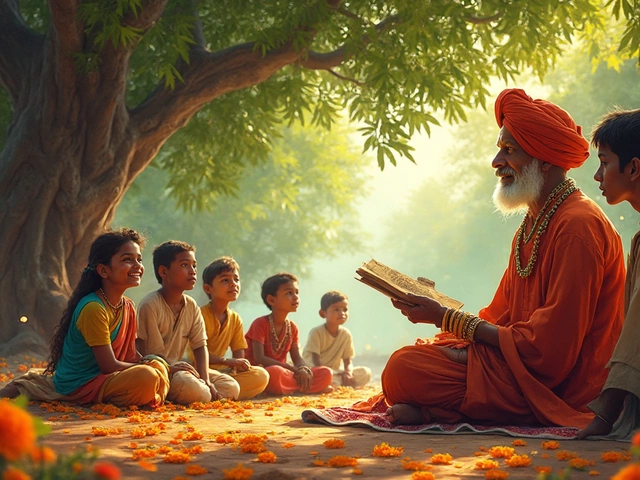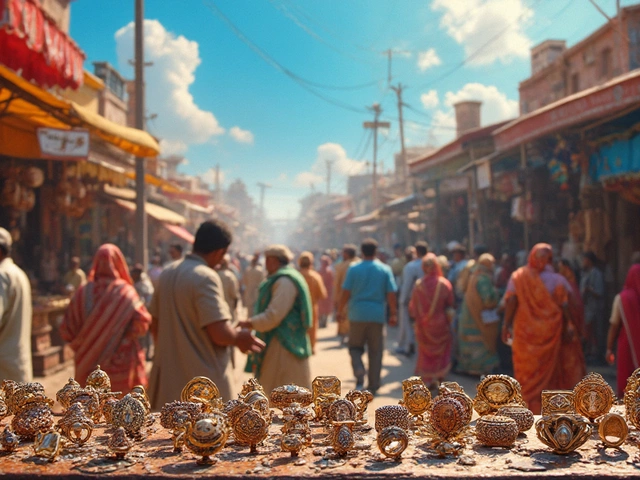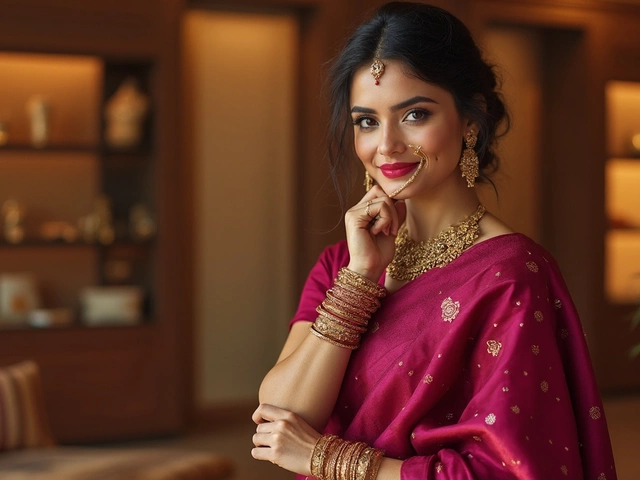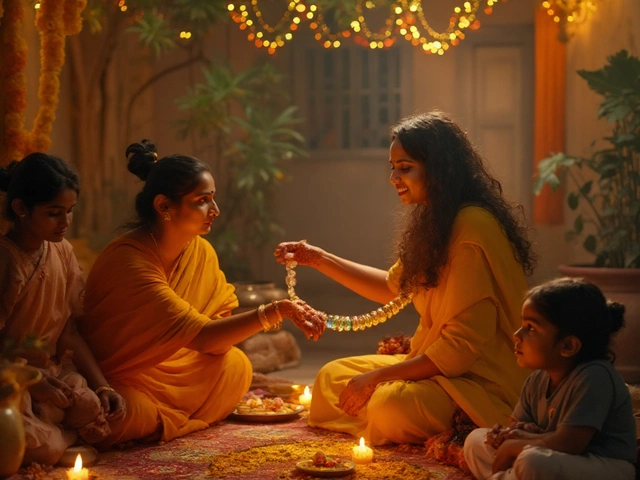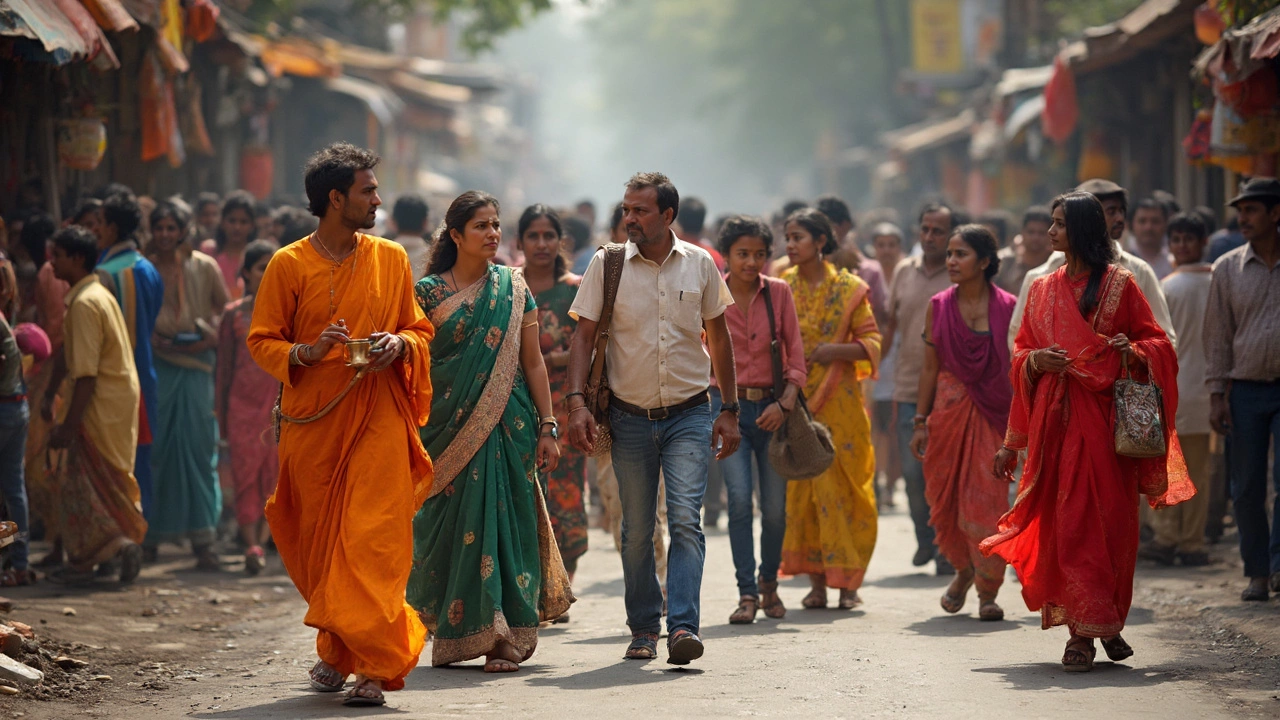
Picturing everyone in India wrapped in sarees or fancy turbans? That's not the real story. Day-to-day, most Indians go straight for comfort and what works for the weather. You'll see a mix of jeans, t-shirts, simple shirts, kurtas, and comfy pants on city streets. Traditional clothes do pop up, but mainly at festivals, weddings, or family get-togethers.
Weather is a big deal here. Summers can get brutal, so lightweight cotton fabrics are everywhere. Folks in Delhi dress differently from folks in Kerala—the climate drives people's closets. Light, breathable styles rule in hot places, while you'll spot more layers in the chilly north or during the monsoon.
Unlike in some Western countries, clothes here often have a practical edge. Dupattas, stoles, and scarves aren’t just style statements—they’re for sun protection, catching sweat, or politely covering up in temples. Even jewelry and bangles can have a job, from showing off marital status to warding off sunburn (seriously, some wear silver anklets for that reason!).
- The Real Daily Wardrobe
- Big Regional Differences
- Top Must-Have Accessories
- Practical Style Tips for India
The Real Daily Wardrobe
Walk down any busy street in Mumbai, Bengaluru, or Kolkata, and you’ll spot people wearing a mash-up of global and local styles. Jeans and T-shirts are absolutely everywhere, especially among young people and folks heading to school or work. For men, button-up shirts, polos, and even simple tees are super common, often paired with jeans or trousers. On extra hot days, some stick to lightweight shorts for errands or chilling at home.
Women have an even wider mix. You’ll see plenty of salwar kameez sets (that’s a long top with comfy pants and a scarf). The kurti-with-leggings combo is another favorite, especially for people commuting on crowded trains and buses. In larger cities, western wear—think tops, dresses, and jeans—has become pretty normal, especially at offices or malls, but traditional kurtas and modest styles are still preferred in many small towns and homes.
Don’t think sarees are just museum pieces. Many older women and people in traditional households wear sarees every single day, although they usually pick lightweight cotton or synthetic blends that are easy to move around in. In fact, over half of rural women still wear sarees regularly, based on the National Family Health Survey (2021).
Kids and teens love sportswear—track pants and branded shoes are everywhere after school. School uniforms are strictly followed across most of India, so you'll notice a switch to casual outfits right after the final bell rings.
If you’re curious about the main differences in what people actually pick out of their closets, it often comes down to three things: weather, age, and occasion. Most adults blend western and Indian outfits through the week, but when it’s time for a festival, everyone brings out their flashiest traditional looks.
| Outfit | Popular With | When It's Worn |
|---|---|---|
| Jeans & T-Shirts | All ages | Daily, work, college, shopping |
| Salwar Kameez | Women (mostly adults) | Work, home, casual outings |
| Saree | Women (mainly 35+ in rural areas) | Home, social events, festivals |
| Kurta & Pajama | Men | Casual, prayers, traditional days |
| Western Dresses | Women (young adults, city-based) | Parties, office, outings |
If you’re visiting and wondering what to pack, stick with breathable fabrics. Most people don’t go too flashy day-to-day, so comfy basics will help you blend right in. Trends come and go, but finding the right mix of comfort, function, and cultural sensitivity is the real secret to fitting in with the India fashion crowd.
Big Regional Differences
India isn't one size fits all—what people wear changes a lot from place to place. Ask someone in Mumbai what their go-to outfit is, and it’ll be different from what you’d hear in Kolkata or Punjab. One big reason is climate, but local traditions and lifestyles play a huge part too.
Quick crash course: North India is famous for its cool winters. So, in Delhi or Himachal, you’ll spot people layering up, sometimes rocking puffer jackets, sweaters, and thick shawls. Men often wear kurta-pajamas or jeans, and women love salwar suits and cozy phirans (especially in Kashmir). Come summer, everyone switches to lighter fabrics. South India, meanwhile, stays hot and humid almost year-round. Men usually go for simple cotton shirts with lungis (a sort of sarong) or pants, and women wear airy sarees or churidar sets—all cotton, all about beating the heat.
If you’re in the west, especially in Gujarat or Rajasthan, you can’t miss the burst of color. Tourists love taking snaps of women in bright lehengas, odhnis (long scarves), and chunky silver jewelry. Men often sport turbans, called pagris, and comfortable dhotis. These styles aren’t just for show—they’re part of daily life in small towns and villages.
Head to the east, and you'll find sarees styled in dozens of unique ways. In West Bengal, women wrap their sarees differently than in Assam, where the mekhela chador is the star. Kolkatans, especially teens and office goers, are often seen in jeans, tees, or smart formal shirts with trousers. It’s a true mix of old and new.
Urban centers like Bengaluru and Hyderabad? Here, trendy Western wear is everywhere. College students wear hoodies, joggers, or business-casual gear. Tech city crowds rarely stick to one style—whatever’s comfy and easy to keep clean makes the cut.
Here’s a comparison of everyday wear across a few major regions:
| Region | Men's Common Wear | Women's Common Wear | Climate Factor |
|---|---|---|---|
| North India | Kurta-pajama, jeans, sweaters | Salwar suit, saree, shawls | Hot summers, cold winters |
| South India | Cotton shirt, lungi, pants | Cotton saree, churidar | Hot and humid |
| West India | Dhoti, shirt, pagri | Colorful lehenga, odhni | Hot, often dry |
| East India | Pants, shirt, lungi | Saree, mekhela chador | Warm, humid, heavy monsoon |
| Urban Metros | Jeans, t-shirt, business-casual | Kurti, jeans, formal wear | Mixed; air-conditioned offices |
What ties it all together? Indians are practical—they’ll pick outfits that match the weather and the hustle of their city or village. The bottom line: The India fashion scene is a mishmash of climate hacks, local customs, urban influences, and pure comfort.
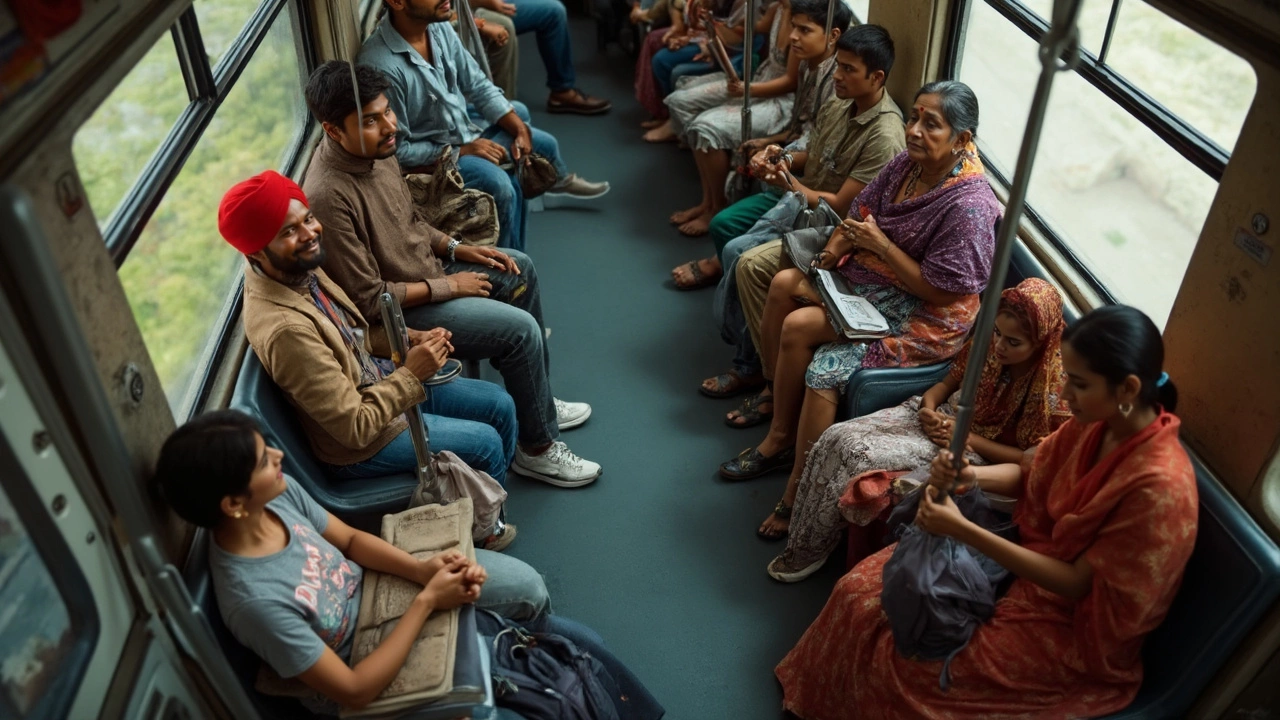
Top Must-Have Accessories
If you’re checking out what really pulls together an outfit in India, look at the accessories. These are essentials, not just add-ons. In every city or small town, people wear at least one of these accessories on the regular—even if their outfit is a plain t-shirt and pants.
Indian accessories are everywhere, and you can spot how practical and personal they are. Here’s the shortlist that almost everyone living in India uses:
- Dupattas and Scarves: These thin cloth pieces are lifesavers. People use them to cover their head in temples, block sun, or just jazz up a look. Bustling markets and city buses—these are everywhere, not just on traditional clothes.
- Bangles and Bracelets: Women and girls love stacking metal, glass, or plastic bangles on their wrists. Some wear them for cultural reasons—like red for married women, or green for festivals—but mostly it’s just for fun and color. Guys might go for leather or thread bracelets.
- Bindi and Sindoor: Many married Hindu women keep a small red dot (bindi) on their forehead, and sindoor (a red powder) in their hair parting. It signals marital status, but you’ll see bindis used as a quirky sticker or fashion statement too, especially at parties.
- Earrings and Nose Rings: Almost every woman wears earrings—silver hoops, gold studs, or big colorful jhumkas. In some parts, nose rings are a daily wear as well. Men sometimes wear small studs or hoops, but it’s less common.
- Footwear: Open sandals rule because of the heat. Flip-flops, floaters, and juttis (a type of colorful slip-on shoe) are super practical and work with both jeans and kurtas.
- Shades and Sun Hats: The sun in India is no joke, so sunglasses (even knockoffs) and bucket hats are everywhere, especially from March to July.
Accessories also come with their own market. According to Statista, the Indian fashion accessories market was valued at around $1.5 billion in 2024, and is growing fast as young people want new types of bags, watches, and statement jewelry.
| Accessory | % of Urban Users (Age 18-45) |
|---|---|
| Scarves/Dupattas | 68% |
| Bangles/Bracelets | 74% |
| Earrings | 82% |
| Footwear (Sandals/Flip-flops) | 91% |
| Sunglasses | 53% |
| Smart Watches | 27% |
If you’re planning to visit or just want to fit in, you can’t go wrong grabbing a printed scarf and a pair of comfy sandals. Want to stand out? Try local market jewelry—it’s cheap, unique, and way more fun than anything at a mall.
Practical Style Tips for India
Thinking about what to pack or wear every day in India? Go for comfort, function, and clothes that blend in when needed. You'll avoid sticking out and deal better with the weather and crowds. Here are straight-up tips to keep you comfy and confident in the Indian climate and culture:
- India fashion starts with fabric. Cotton and linen are your best friends — they breathe, don't cling, and dry fast when you're sweating buckets. Synthetic stuff gets sticky fast, especially in humid spots like Mumbai or Chennai.
- Plan for layers. Northern India can surprise you with chilly nights in winter. A light jacket or sweater goes a long way, even in hot cities like Delhi once the sun drops.
- Cover up at religious places. For temples, mosques, and some churches, you’ll need to wear clothes that cover shoulders and knees. Women might need a scarf or dupatta to cover their head in some places, so toss one in your backpack just in case.
- Quality sandals or slip-on shoes are a lifesaver. Many places (especially homes and sacred spots) require you to take off your shoes, so forget the tricky boots and tight sneakers.
- Beat the sun! A cap, sunglasses, and a big bottle of water are non-negotiable in summer cities. It’s not about style here—it’s about not frying in the sun.
- If you're in rural areas or smaller towns, tone it down. Loud logos or skimpy clothes attract stares and can feel disrespectful. In big cities, you have more freedom with shorts or sleeveless tops, but still, public transport or markets are a different ballgame altogether.
Check out this quick data on average temperatures and humidity in top Indian cities:
| City | Summer Avg Temp (°C) | Winter Avg Temp (°C) | Avg Humidity (%) |
|---|---|---|---|
| Delhi | 40 | 13 | 50 |
| Mumbai | 33 | 20 | 75 |
| Bangalore | 34 | 16 | 60 |
| Kolkata | 36 | 14 | 80 |
So, if you’re shopping for clothes in India, don’t stress about going traditional all the time—mix in light western wear, but stay aware of what fits the local vibe. Smart accessories like hats, watches, or simple jewelry can boost your look while being totally functional.

